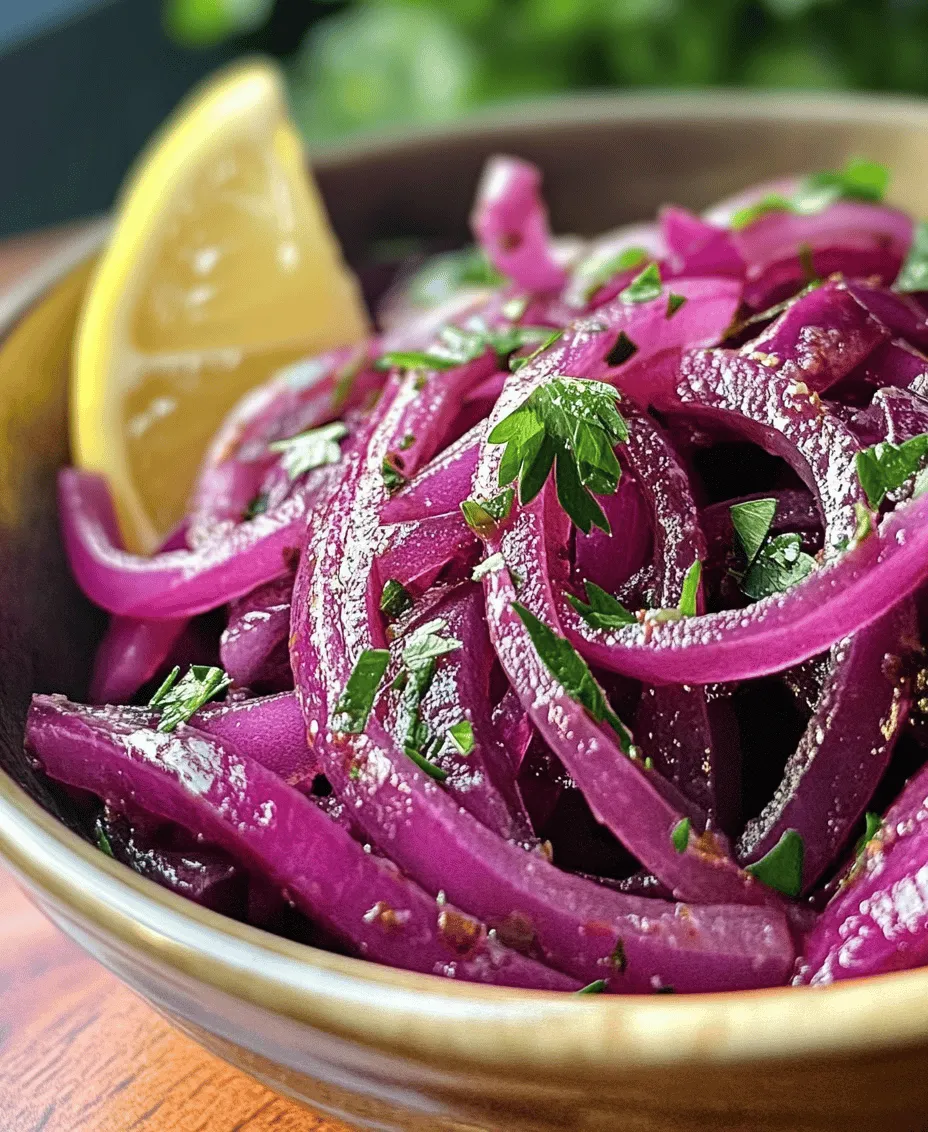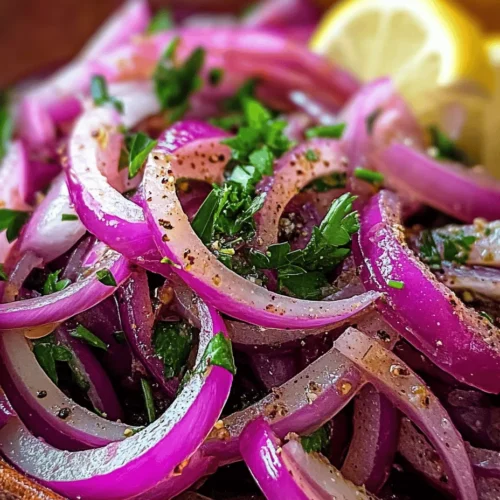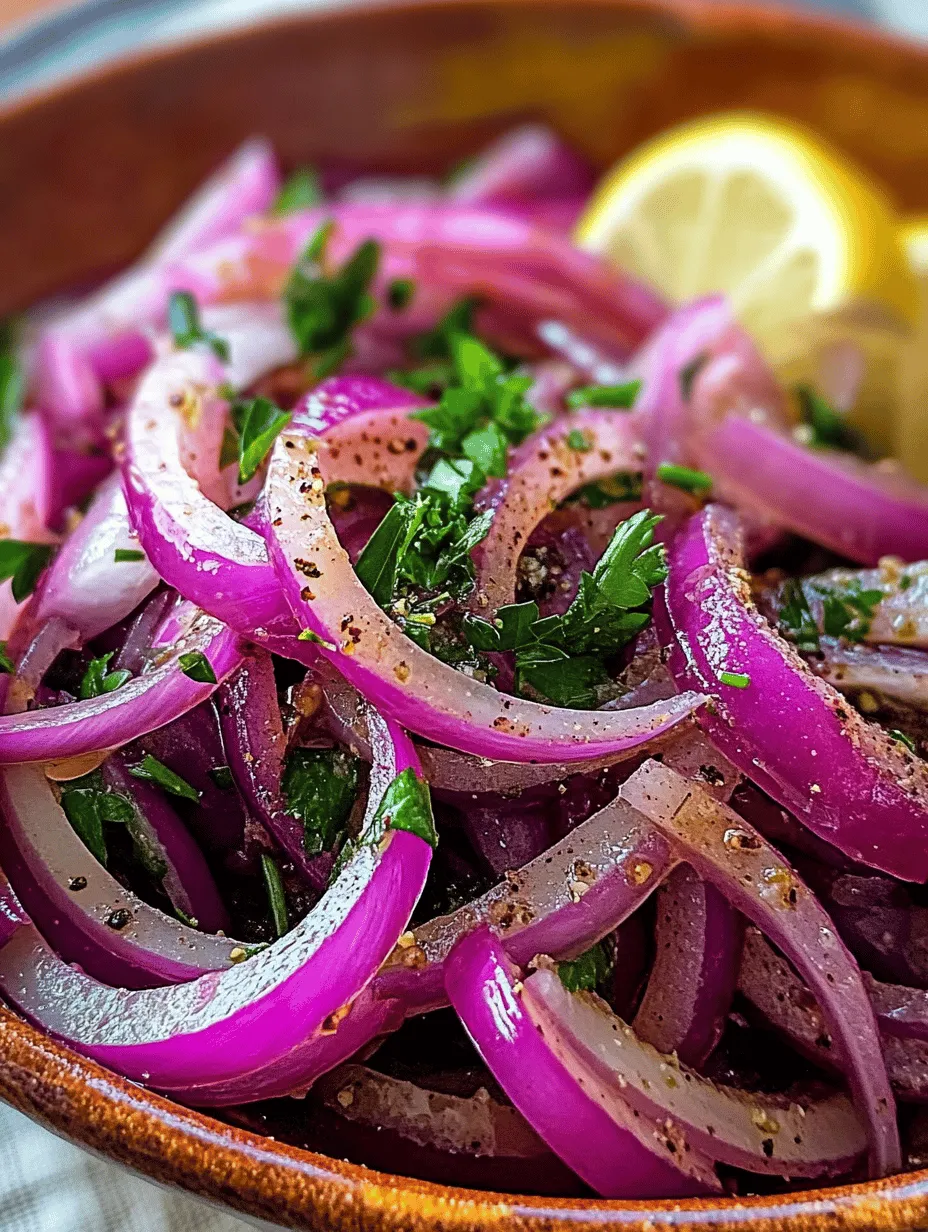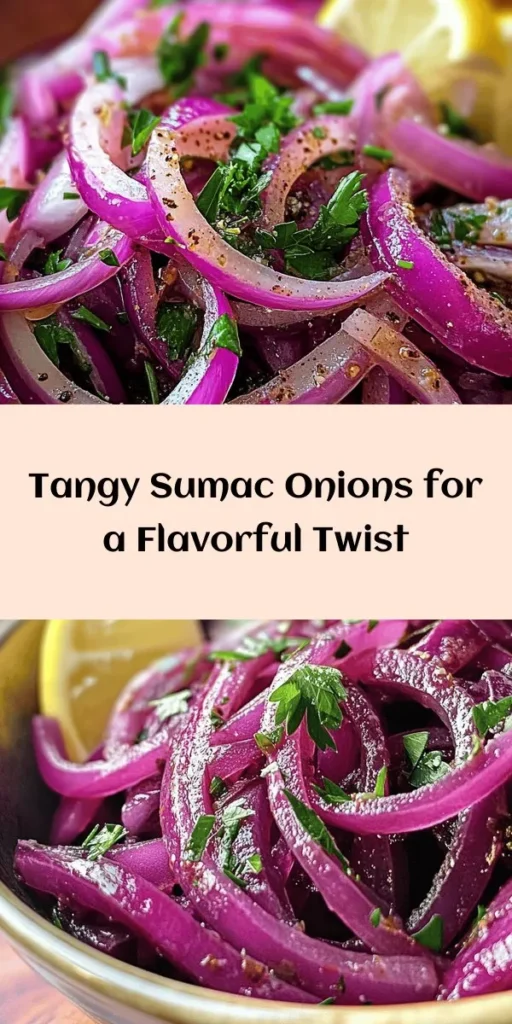Introduction
If you’re looking to elevate your culinary creations with a unique and zesty touch, look no further than Tangy Sumac Onions. This dish is not just a condiment; it’s a vibrant addition that can transform a simple meal into a flavorful experience. With roots deeply embedded in Middle Eastern cuisine, sumac provides a distinct tartness that pairs beautifully with the natural sweetness of red onions. This recipe not only adds color and flavor to your plate but also brings a touch of cultural significance that connects you to a rich culinary tradition.
Sumac is often described as having a tangy, lemony flavor, making it an exceptional seasoning that enhances a variety of dishes. It has been used for centuries in Mediterranean and Middle Eastern cooking, earning its place as a staple in spice blends like za’atar. The health benefits of sumac are equally compelling; it is rich in antioxidants and boasts anti-inflammatory properties, making it a flavorful option that is also good for you.
Tangy Sumac Onions are incredibly versatile. Whether served as a topping for grilled meats, a garnish for salads, or even as a side dish, these onions can add a burst of flavor to almost any meal. Their vibrant color and tangy taste not only enhance the aesthetics of your dish but also provide a delightful contrast that awakens the palate.
Understanding Sumac: The Star Ingredient
Sumac, derived from the dried and ground berries of the Rhus genus of shrubs, is a spice that has been cherished throughout the Middle East and Mediterranean for its tart flavor and vibrant color. The berries are harvested from the sumac tree, dried, and ground into a fine powder, which is then used to season a variety of dishes. Its tangy profile is often compared to lemon juice, making it an ideal seasoning for those looking to add a citrusy punch without the acidity.
The culinary uses of sumac are diverse. It can be sprinkled over salads, mixed into marinades, or used to enhance the flavor of meats and vegetables. In Middle Eastern cuisine, sumac is frequently featured in dishes like tabbouleh and fattoush, where it adds a refreshing tang that balances the richness of other ingredients.
Beyond its flavor, sumac is also known for its nutritional benefits. It is packed with antioxidants, which help combat oxidative stress and may reduce inflammation in the body. This makes sumac not only a flavorful addition to your meals but also a health-conscious choice. Incorporating sumac into your diet can contribute to overall well-being, making Tangy Sumac Onions not just a delicious condiment but a nutritious one as well.
The Appeal of Red Onions in Cooking
When it comes to choosing the right onion for your Tangy Sumac Onions recipe, red onions stand out for several reasons. Their deep purple skin and vibrant color make them visually appealing, but their flavor profile is what truly sets them apart from other onion varieties. Red onions are known for their mild, slightly sweet taste, which becomes even more pronounced when marinated. This makes them the perfect candidate for a dish that seeks to balance tanginess and sweetness.
Nutritionally, red onions are a powerhouse. They are rich in vitamins C and B6, potassium, and a variety of antioxidants, which contribute to their health benefits. Additionally, red onions contain quercetin, a flavonoid that has been shown to have anti-inflammatory and immune-boosting properties. This nutrient density makes them a great choice for anyone looking to enhance their meals with healthy ingredients.
Comparatively, when placed alongside yellow or white onions, red onions have a milder flavor, which can be particularly appealing in raw preparations. This characteristic is crucial for Tangy Sumac Onions, where the goal is to create a dish that is both flavorful and accessible. The combination of the tangy sumac and the sweet, crisp texture of red onions creates a delightful contrast that will enhance a variety of dishes.
Step-by-Step Guide to Making Tangy Sumac Onions
Ingredients
To create your Tangy Sumac Onions, you’ll need the following ingredients:
– Red onions: Their sweet and mild flavor is key to the dish.
– Sumac: The star ingredient that adds tanginess.
– Olive oil: A high-quality olive oil will enhance the overall flavor.
– Vinegar: Red wine or apple cider vinegar works best for balancing sweetness.
– Honey: A touch of honey complements the acidity and adds depth.
– Salt: To enhance the flavors of the onions.
– Optional herbs: Fresh parsley or mint can be added for extra flavor and freshness.
Importance of Using High-Quality Olive Oil
When you’re preparing Tangy Sumac Onions, the quality of your olive oil can significantly impact the overall flavor of the dish. A good extra virgin olive oil will have a robust flavor that can enhance the sweetness of the onions and the tanginess of the sumac. Look for oils that are cold-pressed and have a rich, fruity aroma. This investment will pay off in both taste and health benefits, as high-quality olive oil is packed with heart-healthy fats and antioxidants.
The Role of Vinegar and Honey in Balancing Flavors
The combination of vinegar and honey is essential to achieving the perfect balance in your Tangy Sumac Onions. The acidity from the vinegar cuts through the richness of the olive oil and the sweetness of the onions, providing a refreshing tang that brightens the dish. Meanwhile, the honey adds a subtle sweetness that complements the tanginess of the sumac and balances the overall flavor profile.
Instructions for Preparation
1. Slice the Red Onions: Begin by thinly slicing the red onions. The thinner the slices, the more the onions will absorb the flavors of the marinade. Aim for slices that are about 1/8-inch thick for the best results.
2. Prepare the Marinade: In a mixing bowl, combine a generous sprinkle of sumac with a splash of high-quality olive oil, a couple of tablespoons of vinegar, and a drizzle of honey. Add a pinch of salt to enhance the flavors. Adjust the amounts according to your taste preferences, keeping in mind that sumac is the star of this dish.
3. Combine: Add the sliced onions to the marinade and toss them gently to ensure that each slice is coated evenly. Allow the onions to marinate in the mixture for at least 30 minutes. This step is crucial; it allows the flavors to meld and the onions to soften slightly, enhancing their sweetness.
4. Optional Additions: For added flavor and a burst of freshness, consider stirring in some chopped herbs like parsley or mint just before serving. These herbs not only enhance the flavor but also add a pop of color to your dish.
5. Serve: After marinating, your Tangy Sumac Onions are ready to be served! They can be enjoyed immediately or stored in the refrigerator for up to a week. The longer they sit, the more flavorful they become, making them a fantastic make-ahead option for meal prep.
By following these steps, you’ll create a delicious and vibrant condiment that can complement a wide variety of dishes, from grilled meats to fresh salads. The balance of flavors in Tangy Sumac Onions will impress both family and guests alike, making it a staple in your culinary repertoire.

Tips for Thinly Slicing Onions for Optimal Marination
Slicing onions thinly is crucial for achieving the perfect marination in your Tangy Sumac Onions. Here are some expert tips to help you master this technique:
1. Use a Sharp Knife: A sharp knife will make clean cuts through the onion without crushing it, which is essential for even marination. Dull knives can bruise the onion, leading to a mushy texture.
2. Chill the Onion: Before slicing, refrigerate the onions for about 30 minutes. Chilling can help reduce the release of sulfur compounds that cause tearing, making the slicing process more comfortable.
3. Cut Off the Ends First: Start by cutting off both ends of the onion, then peel away the outer skin. This creates a stable base for slicing.
4. Slice from Root to Tip: Position the onion with the root end facing away from you. This allows for more control as you slice from the top (tip) down towards the root. Aim for slices that are about 1/8 inch thick for optimal marination.
5. Use a Mandoline for Uniform Thickness: If you have a mandoline slicer, it can help achieve perfectly even slices quickly. Just be cautious and use the hand guard to prevent any accidents.
6. Soak in Water: If you’re sensitive to onion fumes, consider soaking the slices in cold water for about 10 minutes after slicing. This can help mellow the flavor and make them less pungent.
By following these tips, you’ll ensure your onions are sliced perfectly for marinating, which enhances their flavor and texture in the final dish.
Explanation of the Marination Process and Its Impact on Flavor
Marination is a crucial step in the preparation of Tangy Sumac Onions, as it allows the flavors to meld together, resulting in a more vibrant taste. Here’s how the marination process works:
– Flavor Absorption: When you marinate onions in a mixture of olive oil, lemon juice, and sumac, the onions absorb these flavors. This is especially effective with thinly sliced onions, as their surface area is larger compared to thicker cuts.
– Softening the Onions: The acid in the lemon juice helps to break down the onion’s cell walls, softening them and making them more palatable. This process not only enhances their flavor but also makes them less harsh and more enjoyable in various dishes.
– Temperature and Time: For optimal results, let the onions marinate for at least 30 minutes at room temperature or up to a few hours in the refrigerator. The longer the marination, the deeper the flavor penetration. However, avoid marinating for too long (more than 12 hours) as the onions can become too soft and lose their crunch.
– Balancing Flavors: Sumac, with its tangy and slightly citrusy flavor, complements the acidity of the lemon juice. The olive oil adds richness, balancing the tanginess while also helping to coat the onions, ensuring that every bite is flavorful.
Serving Suggestions for Tangy Sumac Onions
Tangy Sumac Onions are a versatile addition to a variety of meals. Here are some creative ideas for incorporating them into your dishes:
As a Topping for Grilled Meats
One of the simplest yet most effective ways to enjoy Tangy Sumac Onions is as a topping for grilled meats. The acidity and sharpness of the onions cut through the richness of meats like lamb, chicken, or beef, elevating the overall flavor profile. Simply sprinkle the marinated onions over your grilled proteins just before serving for a burst of freshness.
Incorporating into Sandwiches and Wraps
Add a layer of flavor and crunch to your sandwiches and wraps by including Tangy Sumac Onions. Their zesty taste pairs wonderfully with a variety of fillings, from grilled vegetables to roasted meats. For a Mediterranean-inspired wrap, combine them with hummus, grilled chicken, and fresh greens for a satisfying meal.
Using as Part of a Mezze Platter
Tangy Sumac Onions make an excellent addition to a mezze platter, enhancing the visual appeal and flavor variety. Serve them alongside classic dips like tzatziki, baba ganoush, and muhammara, along with pita bread and assorted olives. This combination allows guests to experience a delightful array of flavors and textures.
Creative Recipes that Complement Tangy Sumac Onions
Consider incorporating Tangy Sumac Onions into creative recipes such as:
– Tacos: Use them as a topping for fish or chicken tacos, adding brightness and crunch to each bite.
– Salads: Toss them into salads with greens, feta cheese, and cucumbers for an extra layer of flavor.
– Grain Bowls: Layer them in grain bowls with quinoa, roasted vegetables, and a protein of your choice for a nutritious meal.
Health Benefits of the Ingredients
The ingredients in Tangy Sumac Onions not only contribute to delicious flavors but also offer numerous health benefits:
Olive Oil: Rich in healthy monounsaturated fats, olive oil is known for its heart-healthy properties. It contains antioxidants and anti-inflammatory compounds that can help reduce the risk of chronic diseases.
Onions: Onions are low in calories yet packed with nutrients. They are a good source of vitamins C and B6, manganese, and dietary fiber. The antioxidants found in onions support immune health and may help reduce inflammation.
Sumac: This tangy spice is rich in antioxidants and has been shown to have anti-inflammatory properties. Sumac is also known to aid digestion and may help regulate blood sugar levels.
Marinated Vegetables: Consuming marinated vegetables like Tangy Sumac Onions can enhance the nutritional value of your meals. The marination process not only improves flavor but also makes the nutrients in these vegetables more bioavailable, allowing your body to absorb them more efficiently.
Final Thoughts on Tangy Sumac Onions
Tangy Sumac Onions exemplify the beauty of simplicity in cooking. They are easy to prepare, requiring minimal ingredients and effort. This recipe opens the door to creativity, encouraging you to experiment with flavors and adapt it to suit your personal preferences.
The cultural significance of food is profound; it brings people together and creates connections through shared experiences. By preparing and sharing dishes like Tangy Sumac Onions, you can introduce others to new flavors and culinary traditions, fostering a sense of community and belonging.
Conclusion
In summary, Tangy Sumac Onions are not only a flavorful addition to your culinary repertoire but also a healthy one. Their unique combination of tangy, rich, and crunchy elements makes them an excellent choice for enhancing a wide variety of dishes. Whether you use them to elevate grilled meats, add crunch to wraps, or serve them as part of a mezze platter, their versatility is unmatched.
Embrace the joy of cooking and exploring new flavors with Tangy Sumac Onions. Allow yourself to be inspired by the vibrant tastes and health benefits these ingredients offer, and don’t hesitate to experiment with this recipe to make it your own. Enjoy the process and the delicious results that come from sharing food with loved ones, creating cherished memories along the way.



